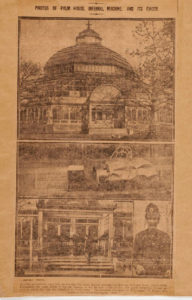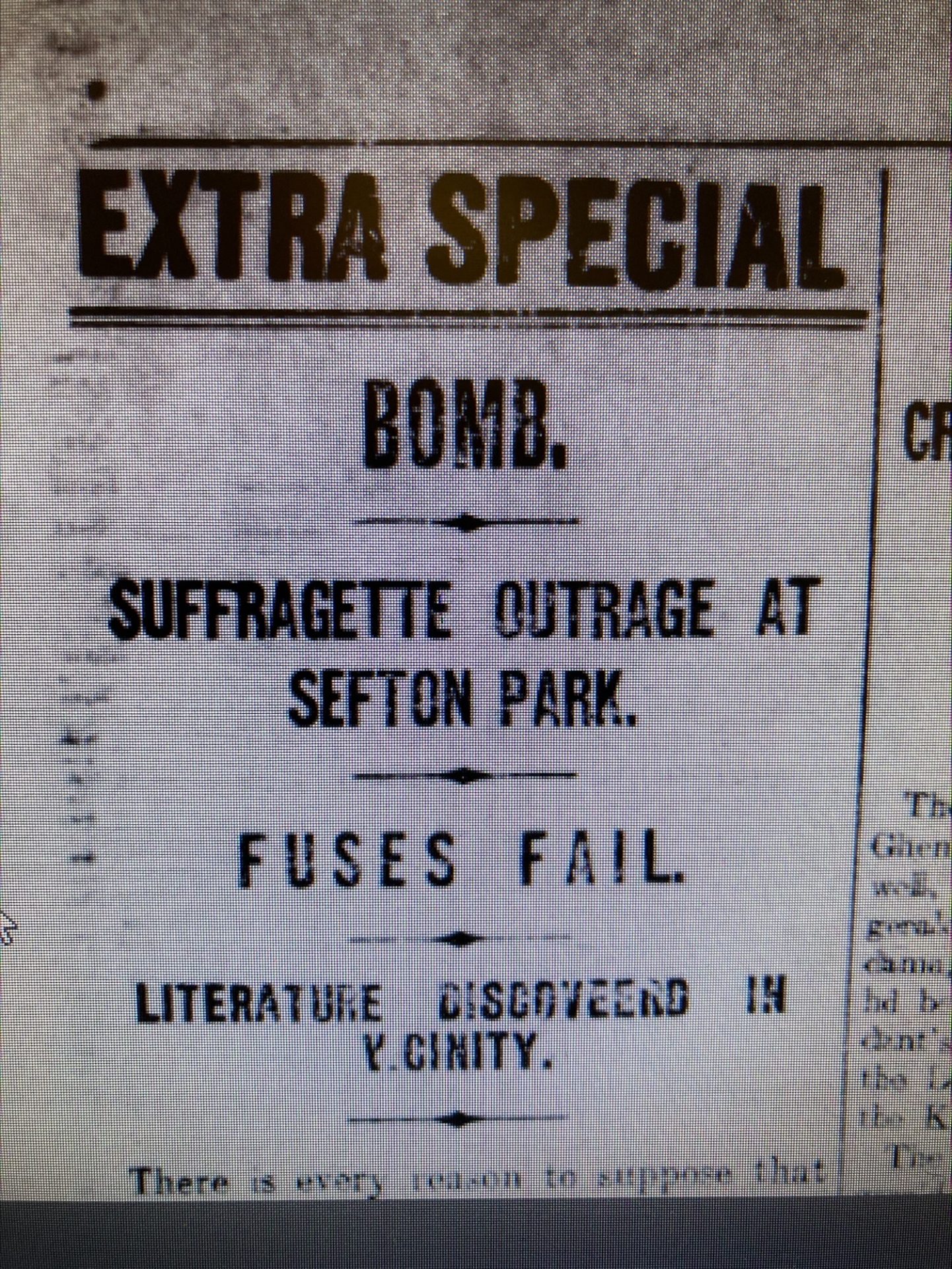“A most interesting and busy time….” – Kitty Marion and the attempted bombing of Sefton Park Palm House
If you had been out walking in Sefton Park on the night of the 13th/14th of November 1913 – defying a sudden change in the weather that had bought strong winds, rain, and hail – you may have seen a middle aged woman walking toward the Palm House carrying what looked like a number of heavy packages. Although her head was covered with a mill-girls shawl you could have glimpsed her red hair. Although she was walking furtively, avoiding been seen, you might put this down to an understandable caution given it was dark and a public park. Possibly she hurrying home to avoid the worst of the weather. The Liverpool Evening Express, the following day, reported that the calm autumnal weather of the preceding week had given way to a sudden drop in pressure as a weather front veered toward the NW bringing with it a “strong NW gale accompanied by driving showers of hail and rain…. And violent winds”. (2).
“A most interesting and busy time….” (1)
Kitty Marion and the attempted bombing of Sefton Park Palm House
Noel Brown, ‘Park Policeman’, was also out that night, doing his rounds. Although reported by the Express as W Disley who was on duty that night, the Sefton Park Committee minutes report that it was, in fact, Brown who discovered a package on a bench by the Palm House containing “suffragette literature”. He was immediately alarmed and made a quick search of the surrounding area but saw no one else. His alarm was justified. Only a few nights before the Cactus House in Alexandra Park, Manchester, had been severely damaged by a pipe bomb (3). There was an ongoing bombing and arson campaign by militant suffragettes, and they were particularly active in the NW. These bombings were often accompanied by the discovery of suffragette literature (4).
On closer inspection the package of literature was found to be a number of items, described in the Express as ‘extraordinary messages’. A handwritten message on a large piece of card read ‘Stop Torturing God’s human plants who are fighting for Votes for Women’. You can almost sense the reporter from the Express puzzling over his message, but it appears to be a reference to the botanical collection in the Palm House – one of the most significant in the country. The message appeared to be saying; ‘You look after plants better than you do women’. There was also a copy of the suffragette newspaper ‘Votes for Woman’ dated 7.11.13 (with, it is reported, a passage marked but unfortunately with no other details). There was a second piece of card with four quotes pasted to it. One was a quote from French intellectual Alphonse Lamartine; “There is a woman at the beginning of all great things”. There were also quotes from essayist Charles Lamb and Robert Buchanan’s poem ‘Could God be Judged’. Finally, and with a possible note of historical irony, there was a quote from Tobias Smollett’s poem ‘Independence’ which concluded with the lines “Nor heard the storm that howls along the sky” (5).

An Infernal Machine
When Noel Brown’s shift ended, he was replaced by William Disley (pictured in the Express in his Constable’s uniform). Disley conducted a further search, and it was at this point that the bomb was found. It had been placed behind the locked gate to the east porch of the Palm House. The Palm House was laid with its four gates pointing to the four points of the compass, The East porch may have been chosen because it was sheltered from the wind. For a minute Disley must have wondered what he was looking at. Later described by the Liverpool Evening Express as ‘an infernal machine’ and by the police as ‘formidable’ (6) Disley found a photographers lantern filled with fuel that was attached by a fuse to an earthenware hot water bottle – or bedpan – about 10 inches in length. The bottle had been wrapped in what looked like a brown paper bag. The paper had burnt round the fuse and there were a number of spent matches nearby as well as scratch marks on the brickwork testifying to the difficulties lighting the fuse. The fuse showed signs of having been lit but blown out – probably due to the sudden change in the weather bringing as it did, storms and high winds. The Liverpool Evening Express recounted the details under a headline which read; “Bomb – Suffragette Outrage at Sefton Park – fuses fail”. The Police began investigating although they already had a number of suffragettes under close surveillance.
“There’s every reason to suppose….” (7)
The minutes of Sefton Park committee reported further ‘suspicious females’ seen near to the Palm House including one riding a bicycle. The number of night staff in all Liverpool parks was increased to counter the perceived threat. 1913 was a year of escalating suffragette activity. Emily Wilding Davidson had been killed throwing herself under a horse at the Royal Derby. There was ‘every reason to suppose’, as the Express put it, that the Palm House bomb was another ‘outrage’. In Liverpool on 22nd September Seafield House had been damaged by an arson attack and again suffragette literature had been found. There had been several other incidents already that year (8) as well as the attack a few days earlier in Manchester.
Suspicion fell on a famous / infamous Suffragette, Kitty Marion. Dr Fern Riddel, in her book “10 Minutes to Death!”, reclaiming Kitty as a figure of considerable and central significance to the time in history, says Kitty was responsible:
“It was in Manchester on 11 November that we would have found [Kitty] sneaking through the twilight….her target was the cactus house in Alexandra Park…..the bomb was a suitably unpleasant one, containing a miscellaneous collection of pieces of metal, including such articles as a bed key, an iron chain, bolts, nuts and nails….On November 13, having returned to Liverpool, Kitty left another bomb in the porch of the Sefton Park Palm House” (9). It was, as Kitty said in her unpublished autobiography, “A most interesting and busy time….” (10)
There is no direct physical evidence linking Kitty to these bombs. However, Riddell states that Kitty “…kept a detailed personal scrapbook of the press reports on all the attacks she carried out as a suffragette solider…annotating them by hand” (11). In it, on page 26, there is the full page collection of photographs from the Liverpool Evening Express (12). This may not be entirely reliable – there is no mention or cuttings relating to the Manchester attack for example – but here is no doubt Kitty was closely linked to the bombing campaign. Shortly after the events related here, she would be arrested and sentenced to three years in prison for burning down Hurst Park Racecourse Grandstand in June 1913. She was treated brutally in prison – force fed over 230 times. In another moment of historical irony, there is a short piece next to the photographs in the Express outlining a statement by the Home Office regarding the practice of ‘forcible feeding’ stating ‘None at present’.
These days we would rightly regard the act of placing a bomb in a public place to achieve political ends as abhorrent even though the bomb does appear to have been designed to explode and damage a public building rather than cause casualties. Intriguingly the scrapbook also contains a further cutting relating to the Palm House on page 29 on which Kitty has written ‘Liverpool paper?’. Was this sent to her by a fellow suffragette? Looking at other incidents there were, more often than not, two operatives when an attack took place – an understandable practice in terms of support and practicalities. Kitty probably had some previous knowledge of Liverpool from her days working in dance halls. However, she would have needed detailed knowledge of the locality – including the presence of nightwatchmen – and, in all probability needed help to carry the bomb. Disley is photographed holding the photographers lamp and is looks large and heavy. Added to this there was the package of literature and the earthenware bottle. Did she have an accomplice? How Kitty and her fellow suffragettes made the bomb and planned this particular ‘outrage’ is a matter for further speculation. We may never know.
Peter Walker
Sefton Park Palm House
15/11/23
- Quoted in “Death in 10 Minutes -The forgotten life of radical suffragette Kitty Marion”, Dr Fern Riddell, Pub Hoddle, 2019, pg 223
- Liverpool Evening Express pg 2, 11.13 (from National Newspaper Archive)
- See Alexandra Park — Alexandra Arts (alexandra-arts.org.uk)
- Ann Clayton “The Suffragette Outrages in Liverpool” Liverpool History Journal, 19, Jan 2020, pp29-32
- Liverpool Evening Express pg 5, 15.11.13 (from National Newspaper Archive)
- Quoted Riddell, pg 223, op cit
- Liverpool Evening Express pg 5, 15.11.13 (from National Newspaper Archive)
- Clayton, op cit, pg 31
- Riddell op cit, pg 222
- Riddell, op cit, pg 177
- Riddell, op cut, pg 176
- The scrapbook is kept by the Museum of London and is available digitised and available to view online.



